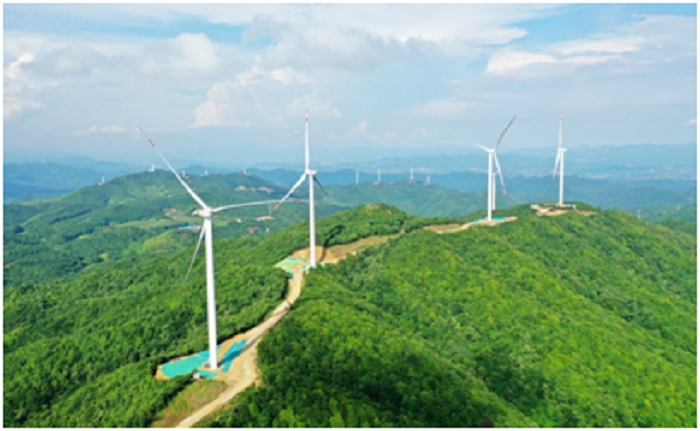



Chinese enterprises have been shouldering corporate social responsibilities in their host countries, progressing China’s Belt and Road agenda. Meanwhile, with the international communities reaching a consensus toward achieving sustainable development goals, experts believe that now is the optimal time to foster green development linked to the Belt and Road Initiative (BRI).
Go green together
The Mombasa-Nairobi Standard Gauge Railways (SGR), part of BRI in Kenya, has established a strict management system, adopting practices and processes that are environmentally responsible throughout the project.
The SGR has invested 220 million Kenyan shillings ($1.97 million) in environmental protection and conducted 236 environmental impact assessments (EIA), according to “2018-2019 Chinese Enterprises in Kenya Social Responsibility Report” by Kenya China Economic and Trade Association.
As for its management of quarries and dump sites, the Chinese contractor has strictly followed environmental protection measures specified in the EIA report during the construction to minimize the impact on the environment.
It has also built noise barriers along the section running through the Nairobi Wildlife Park to reduce the impact of noise on wildlife.
To reduce the impact of noise on surrounding communities, the SGR has also chosen quieter machinery, the report said.
Chinese enterprises operating in Kenya has adopted a proactive approach to environmental impact management and incorporated energy conservation and environmental protection into their day-to-day operations, the report introduced.
Chinese companies are focused on reducing the consumption of raw materials, water and energy by optimizing processes and upgrading technologies.
Meanwhile, companies are working to manage the direct environmental impacts of their construction and operation activities, including liquid effluent, solid waste, air emissions, and noise levels.
Throughout the construction of the C12 Highway Project, China Wu Yi Co, a construction and engineering company, initiated dialogues with local government agencies, wildlife conservation organizations and local communities.
It introduced its wildlife protection experience and practices, developing wildlife protection and rescue operation plans for sections that may have adverse effects on wildlife.
Taking suggestions from wildlife protection organizations, the Chinese company adjusted its work schedule to avoid the impact of construction noise on wildlife.
Chinese enterprises increasingly see ecological restoration as a necessary part of the construction processes.
China Civil Engineering Construction Corporation (CCECC) Kenya signed an agreement with an environmental management company regarding the restoration of the mangrove ecosystem near its construction site in Mombasa.
In response to the Kenyan government’s call for action to protect the environment, PowerChina installed an incinerator to dispose plastic waste generated by the Kenya 330 Highway Project to reduce the release of pollutants into the environment, the report said.
Huawei Technologies (Kenya) has donated approximately $100,000 each year to the Safaricom Marathon, an annual sporting event hosted in the Lewa Wildlife Conservancy for 10 consecutive years.
Global efforts
Working with partners worldwide, China is jointly building a green Belt and Road with concerted efforts to create synergies for global biodiversity conservation.
The Ministry of Ecology and Environment of China (MEE) and partners have jointly initiated the BRI International Green Development Coalition (BRIGC), to build a cooperation platform for green BRI development and achieving the 2030 sustainable development goals together with BRI participating countries.
“China will peak carbon dioxide emissions by 2030 and achieve carbon neutrality by 2060. Immediately after [China], South Korea and Japan made similar promises. In the US, Joe Biden has foreshadowed a green agenda as a core part of his presidency. The EU is driving a green new deal, so all these three main economies are driving the go green direction, and many businesses are doing the same. So this is the most exciting, promising optimistic time for the environment in our generation and we should grasp this opportunity,” Erik Solheim, President of BRI Green Development Institute and former head of UN Environment Program, told the Global Times on December 8.
The BRIGC now has more than 150 partners from over 40 countries and regions.
The BRIGC advisors have recommended that China apply more stringent environmental controls over its outbound investments.
Zhu Chunquan, head of Nature Initiatives and Tropical Forest Alliance at the World Economic Forum in Beijing, told the Global Times on Thursday that BRIGC is conducive to promoting economic, trade and sustainable development cooperation between China and the Belt and Road countries.
“BRIGC integrates with the UN 2030 Sustainable Development Goals (SDGs), global biodiversity targets while addressing challenges of climate change and achieving carbon neutral goals,” Zhu said.
Shared standards
“In terms of investment, project planning, design and implementation or operations, [Chinese companies] need to practice internationally recognized standards and guidelines. It’s more conducive to international dialogue and accepted in the country where the project is located,” Zhu pointed out.
There’s so much enthusiasm now for going green, following China making a commitment on carbon neutrality, Solheim noted.
“There need to be a process between many different stakeholders to create trust and gather feedback to improve the [guidance] system. I don’t see major obstacles as everyone on board can see the benefit of going green,” said Solheim.
Although the UN report finds world leaders fall short of meeting Paris Agreement goal, Solheim said that he is confident that mankind can still achieve the goal.
“It’s up to us,” Solheim said.
Source: Global Times


The Humanitarian Service Diamond Awards has.
A Chinese Company, Inner Galaxy Steel.


The Programme Coordinator, Regulatory, Compliance and.


A Non-Governmental Organization (NGO), Committee for.
The Trustfund Pensions Limited has chided.


The House of Representatives Committee on.
The China General Chamber of Commerce.


Senator Chuka Utazi who represented Enugu.


An Abuja based Legal Practitioner, Ugochukwu.


The African business community in Yiwu,.
Leave a Comment